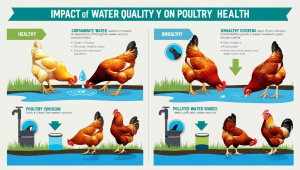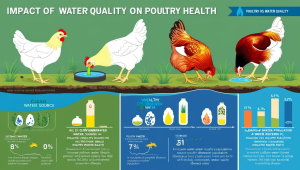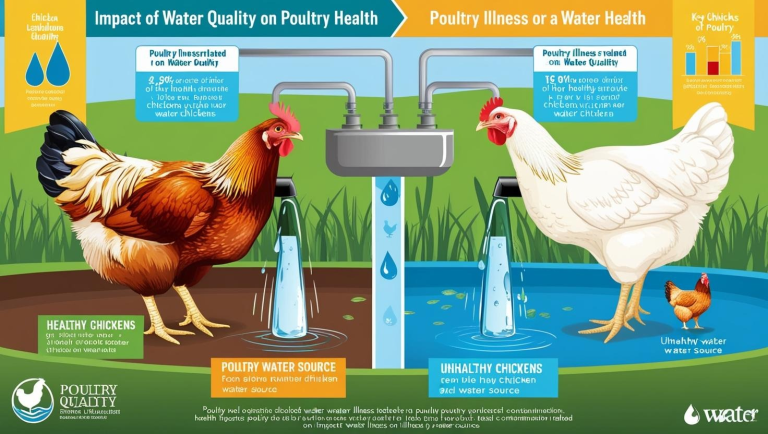Water quality is a crucial factor in poultry production, directly influencing bird health, growth, and overall farm productivity. Contaminated or poor-quality water can lead to disease outbreaks, reduced feed conversion efficiency, and economic losses for poultry farmers. This article explores the importance of water quality in poultry farming, the key contaminants affecting poultry health, methods of water quality assessment, and best practices for maintaining clean water supplies.
Importance of Water Quality in Poultry Health
Water is essential for all physiological functions in poultry, including digestion, nutrient absorption, temperature regulation, and waste elimination. Chickens and other poultry species consume water at a rate two to three times higher than their feed intake, making it critical to ensure a safe and adequate water supply.
a. Role of Water in Poultry Physiology
Digestion and Nutrient Absorption: Water aids in breaking down feed and transporting nutrients through the bloodstream.
Temperature Regulation: Birds regulate body temperature through panting, which increases water loss and necessitates adequate hydration.
Waste Excretion: Water helps flush out toxins and metabolic waste through urine and feces.
Immune System Support: Clean water reduces disease risks, supporting overall bird immunity.
Common Water Contaminants and Their Effects on Poultry

Various contaminants can compromise water quality and negatively impact poultry health. These contaminants include biological, chemical, and physical pollutants.
a. Biological Contaminants
Bacteria and Viruses: Pathogens like Escherichia coli (E. coli), Salmonella, and Clostridium can cause infections, diarrhea, and high mortality rates.
Protozoa and Parasites: Organisms such as Cryptosporidium and Giardia can lead to intestinal diseases.
Algae and Biofilm Formation: Stagnant water sources can develop biofilms, which harbor harmful bacteria and reduce water palatability.
READ ALSO: STUNTED GROWTH IN BROILERS
b. Chemical Contaminants
Nitrates and Nitrites: High nitrate levels can interfere with oxygen transport in blood, leading to reduced growth and poor egg production.
Heavy Metals: Elements like lead, arsenic, and cadmium can accumulate in poultry tissue, causing toxicity and reduced performance.
Excess Minerals (Hard Water): High levels of calcium, magnesium, and sulfates can affect digestive efficiency and lead to poor growth rates.
c. Physical Contaminants
Sediments and Particulates: Dirt, debris, and suspended solids can clog water systems, reducing water flow and intake.
Odor and Taste Issues: Unpleasant smells or tastes, often caused by organic matter decomposition, can reduce water consumption and impact bird performance.
Assessing Water Quality for Poultry Farming
Regular water testing and assessment are essential to maintaining optimal poultry health. Key parameters to monitor include:
a. Microbial Analysis
Total Coliform and E. coli counts should be near zero to prevent disease outbreaks.
Regular testing for Salmonella and other poultry-specific pathogens is recommended.
b. Chemical Testing
pH Levels: Ideal drinking water for poultry should have a pH between 6.0 and 6.8.
Total Dissolved Solids (TDS): Levels should remain below 1,000 mg/L to ensure water safety.
Chlorine Residuals: Chlorine should be maintained at 2-5 ppm for effective microbial control without harming birds.
c. Physical Examination
Water should be clear, free of suspended particles, and odorless.
Any discoloration or unusual smell indicates possible contamination and requires immediate action.
Best Practices for Maintaining Clean Water in Poultry Farms

Ensuring high water quality requires proper management, routine maintenance, and preventive measures.
a. Water Source Management
Use clean and reliable water sources, such as treated municipal supplies, deep wells, or properly maintained boreholes.
Avoid using surface water sources, such as ponds or lakes, without proper treatment.
b. Water System Maintenance
Clean and disinfect water lines, pipes, and drinkers regularly to prevent biofilm buildup.
Flush water lines before introducing a new flock to remove contaminants.
Use water sanitizers, such as chlorine or hydrogen peroxide, to control microbial growth.
c. Water Treatment Techniques
Filtration: Removes sediments, organic matter, and some microbial contaminants.
Chlorination: Kills bacteria and viruses but should be monitored to avoid excessive residual chlorine levels.
UV Treatment: Effective for microbial disinfection without chemical residues.
Reverse Osmosis: Useful for removing dissolved salts and chemical contaminants in water with high TDS levels.
d. Monitoring and Record-Keeping
Establish a routine water testing schedule (monthly or quarterly, depending on farm size and risk level).
Keep records of water test results, treatment schedules, and system maintenance.
Train farm personnel on water management best practices to ensure consistent implementation.
Impact of Poor Water Quality on Poultry Productivity
When water quality is compromised, poultry health and farm productivity suffer. Some common impacts include:
Decreased Feed Intake: Birds reduce their feed consumption when water is unpalatable or contaminated.
Poor Growth Rates: Nutrient absorption is hindered, leading to slower weight gain and lower meat production.
Increased Disease Incidence: Waterborne pathogens contribute to higher mortality rates and increased veterinary costs.
Egg Production Decline: Contaminated water affects layer hens, reducing egg quality and yield.
READ ALSO: Chronic Respiratory Disease(CRD) in Poultry
Future Challenges and Solutions
As global water quality issues become more pronounced due to pollution, climate change, and increased agricultural demands, poultry farmers must adopt sustainable water management strategies.
Investing in Advanced Water Treatment Technologies: Implementing modern filtration and disinfection systems can enhance water safety.
Improving Water Conservation Practices: Reducing wastage and recycling water where feasible can help manage resources efficiently.
Research and Innovation: Continuous research on water quality improvements in poultry farming can lead to better disease prevention and production efficiency.
Conclusion
Water quality plays a critical role in poultry health, productivity, and overall farm success. By understanding the risks associated with poor water quality and implementing effective monitoring and treatment strategies, poultry farmers can enhance bird welfare, optimize production, and ensure sustainable farming practices. Maintaining clean and safe water should be a top priority for every poultry operation aiming for long-term profitability and success.
READ ALSO: Feed Ingredients and Their Nutritional Value
Proper nutrition is the foundation of healthy and productive livestock and poultry. Feed ingredients must provide essential nutrients, including energy, protein, vitamins, and minerals. Understanding the nutritional value of feed ingredients helps farmers formulate cost-effective and…
READ ALSO: Vaccination and Disease Prevention Strategies
Vaccination is one of the most effective methods of preventing infectious diseases in livestock and poultry. It protects animals from deadly infections, reduces mortality, and enhances farm productivity. Implementing comprehensive disease prevention strategies ensures sustainable animal farming…
Click HERE to join our WhatsApp group

